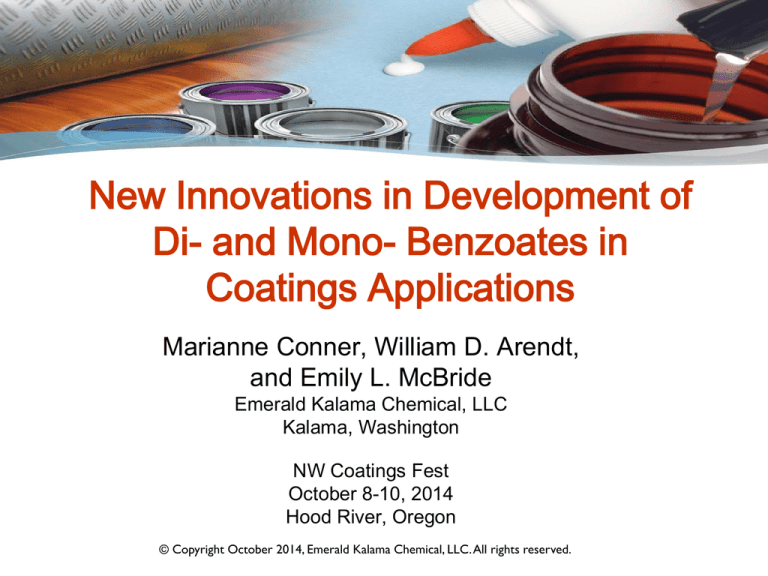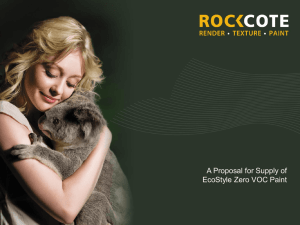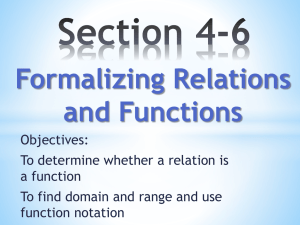
New Innovations in Development of
Di- and Mono- Benzoates in
Coatings Applications
Marianne Conner, William D. Arendt,
and Emily L. McBride
Emerald Kalama Chemical, LLC
Kalama, Washington
NW Coatings Fest
October 8-10, 2014
Hood River, Oregon
© Copyright October 2014, Emerald Kalama Chemical, LLC. All rights reserved.
Presentation Outline
• Background
– Historic benzoate overview
– New products
• Goal
• Evaluation
– Initial benzoate introduction
– Physical properties, volatility, and VOC’s
– Interior architectural paint with higher MFFT polymers
• Partitioning
– Most recent developments in interior paint
– Update on exterior paint performance
• Recap
2
Historical Development
1938
DPG/DEG
dibenzoate 1st patent –
vinyl
application
1953
Patent
US3110603:
polyalkylene
glycol
dibenzoates,
and resinous
compositions
plasticized
therewith.
1990’s
Proprietary
blend of three
dibenzoates
(TEG,DE,DP)
1980
brought to
Introduction of market as a
isodecyl
product with
benzoate as a improved
coalescent/visco VOC, low
sity modifier.
odor,
handling.
2000’s
2-EHB
introduced for
coatings
industry. New
blends of
dibenzoates
introduced
with improved
efficiency and
economics.
Today
New blends of
dibenzoates
introduced with
improved efficiency
and economics.
3
Benzoate Coalescent Development
Benzoates: non-phthalates, commercially available for
decades for coatings and other applications
•Recently created dibenzoate platform was presented in
Waterborne 2011 conference
850S - low VOC diblend of two dibenzoates
975P - low VOC type with lower freeze point than most
diblends, broader range of compatibility in polar
polymers
•Global products
– On inventories in the US, EU, and numerous others
around the world
4
New Products
•
•
In 2013, commercialized:
500P - Lowest VOC of the line of dibenzoates.
Proprietary blend of diethylene and dipropylene glycol
dibenzoates.
Introducing new monobenzoates for coatings:
613 (3–Phenylpropyl benzoate) – Significantly lower
in VOC than TMPDMIB. Listed as a flavor additive in
EU.
BOB (Benzyl benzoate) – Also significantly lower in
VOC than TMPDMIB. Listed as a flavor additive.
5
Goal
•
•
Review previously presented information:
– Interior architectural paint with harder polymer
– Exterior paint
Introduce and discuss most recent results on new
dibenzoate coalescents for use in coatings:
– Interior architectural paint
6
Coalescent VOC’s
VOC Measurement
•
•
In the US, EPA 24 is the guideline on VOC measurement
method
– ASTM D2369 oven volatility method (110ºC for 1 hour)
– 2,2,4-Trimethyl-1,3-pentanediol monoisobutyrate
(TMPDMIB) is 100% volatile as is the diisobutyrate
(TMPDMDIB)
ASTM D6886 under revision:
– A modified version of D6885
– Future of ASTM D6886 use of methyl palmitate boiling
point marker (b.p. 319-321 at standard atmospheric
pressure). Compounds eluting before considered VOC.
8
8
Coalescents Evaluated
•
•
•
•
•
•
•
975P: DPG/DEG/PGDB dibenzoate triblend
850S: Second generation dibenzoate binary blend
500P: Third generation dibenzoate diblend
613: 3–Phenylpropyl benzoate
BOB: Benzyl benzoate
TEGDO: Triethylene glycol di-2-ethylhexanoate,
competitive low VOC coalescent, primary control
TMPDMIB: 2,2,4-Trimethyl-1,3-pentanediol
monoisobutyrate
9
Coalescent Properties
Coalescent
Boiling Point,
°C at 5 mm Hg [760
mm Hg])
Vapor Pressure
(mm Hg at 25°C)
Flash Point
(°C)
TMPDMIB
110 [254]
1.3 x 10-2
120
TEGDO
160 [344]
< 1 x 10-4
195
850S
180 [>330]
9.0 x 10-5
193
975P
215 [>350]
3.6 x 10-6
202
X-613
191 [337]
5.0 x 10-5
193
BOB
156 [320]
8 x 10-3
148
500P
236 [>350]
1.0 x 10-8
232
10
10
Coalescent Vapor Pressure
vs. Boiling Point Curve
Pressure (mm Hg)
1000
100
10
1
1.90E-03
1.95E-03
2.00E-03
2.05E-03
2.10E-03
2.15E-03
1/T, T in Kelvin
TMPDMIB
975P
850S
X-613
BOB
500P
TEGDO
11
11
VOC, 110ºC for 1 Hour
ASTM D-2369, Part of EPA 24
100%
Volatility, % Weight Lost
90%
80%
70%
60%
50%
40%
30%
20%
10%
0%
TMPDMIB
TEGDO
975P
850S
500P
X-613
BOB
12
Volatility by Thermogravametric
Analyzer VOC
13
VOC, ASTM D6886
2.5
1.5
1
0.5
0
VOC
70
Control 0 VOC
1.5% Wt TMPDMIB
1.5% Wt TEGDO
1.5% Wt 975P
1.5% Wt 850S
1.5% Wt 500P
1.5% Wt X613
1.5% Wt BOB
60
50
VOC, g/L
Weight % Lost
2
40
30
20
10
0
VOC
14
Proposed Modification of ASTM D6886
GC VOC Method - Methyl Palmitate BP Marker
% Wt
TEGDO
1.0
975P
850S
0.5
0.0
50
TMPDMIB
500P
X613
BOB
VOC (g/L)
1.5
40
30
20
10
0
Boiling Point at atmospheric pressure of methyl palmitate: 417ºC, 332ºC and 319 - 321ºC.
In California, South Coast Air Quality Management District (SCAQMD) is considering adoption of this method to quantify VOC.
TMPDMIB, TMPDDIB and many other coalescents will be 100% VOC by this definition. (Draft Method 313) if set to this marker.
15
ASTM D6886
with Methyl Palmitate Marker
X-613
16
Initial Coatings Evaluation
•
•
First Experimental Protocol
Goal
Provide data to demonstrate the utility of the new benzoate triblend
for coatings
Formulations
–Three polymers
Vinyl acrylic type: MFFT = 9ºC, Tg = 12ºC
Soft acrylic for low VOC applications: MFFT = 8ºC, Tg = 7ºC
Harder acrylic copolymer: MFFT = 28ºC, Tg = 31ºC
–Three paints
•
•
•
Flat based on vinyl acrylic:
Volume solids = 34.8%, PVC = 58%, VOC = 50 g/L
Semigloss based on acrylic:
Volume solids = 33%, PVC = 29.8%, VOC = 50 g/L
Gloss based on harder acrylic copolymer:
Volume solids = 35%, PVC = 18%, VOC = 160 g/L
18
Total Coatings’ VOC and
Calculated Contribution of Coalescents
VOC's (g/L)
50
40
Total Paint VOC
30
TEGDO
20
850S
TMPDMIB
975P
10
0
Flat, Vinyl Acrylic
Semigloss, Acrylic
19
Experimental Protocols: Tests
•
•
Wet paint and filming – Viscosity, rheology, heat stability,
leveling, freeze/thaw, wet edge/open time, dry to touch,
mud cracking
Dry paint – Adhesion, scrub resistance, blocking, wet
adhesion, dry adhesion, accelerated dirt pick up,
contrast ratio, reflectance, color, gloss
Not all tests run for each evaluation. Not all tests discussed.
20
Semigloss Paint
Blocking Resistance
10
9
8
Rating (0-10)
7
6
5
4
3
2
1
0
1 Day RT
7 Days RT
TMPDMIB
1 Day 120°F
TEGDO
975P
7 Days 120°F
850S
21
Gloss Paint
Scrub Versus Coalescent Concentration
2900
Scrub Cycles
2700
2500
2300
TMPDMIB
850S
975P
2100
1900
1700
1500
15
20
25
30
35
Pounds Coalescent/100 gallons
40
22
Next Step:
Interior Architectural Paint
Based on a Harder Polymer
Paint Formulation Variables
Vinyl Acrylic Flat
Polymer, 7°C MFFT, 22°C Tg
Volume Solids = 38.1%
PVC = 53 %
Coalescent level = 6 pounds/100 gallons
Control TMPDMIB
Low VOC coalescents of 850P, 975P and TEGDO
Acrylic Semigloss
Polymer, 17°C MFFT, 19°C Tg
Volume solids = 34%,
PVC = 22%,
VOC = 150 g/L
Coalescent level = 12 pounds/100 gallons
Control TMPDMB with 150 g/L formula adjusted to < 50 g/L
Low VOC coalescent paints adjusted to < 20 g/L
24
Results
The following tests were equal or similar to the control,
TMPDMIB, in both the flat and the semigloss:
– Wet Adhesion (1 week, gloss alkyd), Viscosity, ICI, Flow &
Leveling.
– Hiding, Freeze / Thaw - 3 Cycles, Dry-to-Touch Time.
– Block Resistance
But there were some positive performance
improvements – Illustrated in the following slides
─ Scrub resistance
─ Scrub resistance versus coalescent concentration
─ Gloss development
25
Vinyl Acrylic Flat Paint
Scrub Cycles
Scrub Versus Coalescent Concentration
1700
1600
1500
1400
1300
TMPDMIB
850S
975P
1200
1100
1000
900
800
0
2
4
6
8
Pounds Coalescent/100 gallons
10
26
Acrylic Semigloss
Scrub Versus Coalescent Concentration
4500
Cycles
4000
3500
TMPDMIB
3000
850S
2500
975P
2000
4
6
8
10
12
Pounds Coalescent/100 gallons
27
Acrylic Semigloss
Block Resistance
TMPDMIB
10
TEGDO
9
975P
8
850S
Rating
7
6
5
4
3
2
1
0
1 Day RT
1 Day 120F
7 Days RT
7 Days 120F
28
Acrylic Semigloss
Gloss development
60º Gloss
80
70
TMPDMIB
TEGDO
975P
850S
60
50
29
New Benzoates
Interior Architectural Paint Based
on Hard Polymer
Paint Formulation Variables
•
•
Vinyl Acrylic Flat
– Polymer, 7°C MFFT, 22°C Tg
– Volume Solids = 38.1%, PVC = 52.8
– Coalescents all at 6 pounds/100 gallons
Acrylic Semigloss
– Polymer, 17°C MFFT, 19°C Tg
– Volume solids = 34%, PVC = 22%
– Coalescents all at 12 pounds/100 gallons
– Control TMPDMIB, 50 g/L formula
– Low VOC paints, < 20 g/L formula
31
Total Coatings’ VOC and
Calculated Contribution of Coalescent
32
Results
•
•
The following tests were equal or similar to the control,
TMPDMIB in both the flat and the semigloss for 500P,
613 and BOB:
– WPG, pH, Viscosity, ICI, Sag
– Contrast Ratio - 3 Mils, Reflectance, Freeze / Thaw 3 Cycles, Dry To Touch Time
But there were some positive performance
improvements:
– VOC reduction
– Better leveling and wet edge in the flat
33
Vinyl Acrylic Flat
Open-time / Wet Edge Rating
Wet Edge Rating: 10, ex c ellent
10
9
TMP DMIB
8
TE GDO
7
B OB
6
X -613
5
500P
4
B lank
3
2
1
0
5 min
6 min
7 min
8 min
9 min
10 min
11 min
12 min
Open-t ime
34
Vinyl Acrylic Flat
Scrub Resistance
800
700
Cycles
600
500
400
300
200
100
0
TMPDMIB
TEGDO
BOB
X-613
500P
Coalescent
35
Semigloss Acrylic
Open-time / Wet edge Rating
Wet Edge Rating: 10, excellent
10
TMP DMIB
9
TE GDO
8
B OB
7
X -613
500P
6
B lank
5
4
3
2
1
0
1 min
2 min
3 min
4 min
5 min
Open-time
36
Semigloss Acrylic
Scrub Resistance
2000
Cycles
1900
1800
1700
1600
1500
TMPDMIB
TEGDO
BOB
X-613
500P
37
Exterior Paint Evaluation
Florida Fence Data to Date
Exterior Paint Test Protocol
•
•
Goal
Determine the performance of commercial dibenzoate blends in exterior
paint
Formulations
–Polymer – Two base polymer emulsions
Low VOC acrylic type: MFFT = 8°C, Tg = 7°C
All acrylic exterior type: MFFT = 11°C, Tg = 9°C
–Paint
Exterior flat - all acrylic exterior type polymer
Volume solids = 38.2%
PVC = 46.0%
Coalescent at 7.7 pounds/100 gallons for each (10% excess)
Exterior semigloss - soft low VOC acrylic polymer
Volume solids = 33.7%
PVC = 29.8%
Coalescent at 3.5 pounds/100 gallons for each
40
Three Year Fence Data:
South and North Vertical
•
•
South Vertical, Southern Pine, Flat paints dried at 4.4°C
– General appearance, mildew: TMPDMIB – 5.5, TEGDO – 6, 850S
– 7.5, 975P – 6
– Dirt pick up: all rated 8.5 - 9
North Vertical, Southern Pine, Flat and Semi-gloss paint dried at
RT
– Flats
•
•
•
General appearance and dirt pick up: all 8’s
Cracking/delamination: all are still rated 10
Mildew: all >8
– Semigloss
•
•
•
All 2’s for mildew and general appearance
Cracking/delamination: all are still rated 10
Dirt pick up: all 7’s
41
Fence Data: South 45°
•
45° South
– General appearance and mildew growth fell below 8
at 18 months
– Dirt pickup fell below 8 after 24 months
42
Partitioning
Partitioning
•
•
Factors affecting the rate of partition into the polymer particles
– Water-insoluble versus water-soluble coalescent types.
– Tg of the polymer, hardness.
– Type of surfactant present.
– Mixing and temperature during incorporation.
Protocol to determine partitioning:
– Mix emulsion.
– Add coalescent at level recommended.
– Take MFFT at different time intervals.
– Consider surfactants – effect on MFFT, particularly HLB value.
44
Minimum Film Formation Temperature
7
6
TMPDMIB
TEGDO
MFFT (°C)
5
KF850S
KF975P
4
3
2
1
0
Initial, 1 hour
1 Day
2 Days
3 day
Coalescents at 3% on the polymer emulsion, or 16 #/ 100 gallons, Polymer MFFT = 16°C.
45
Partitioning with 850S
in Styrenated Acrylic Emulsion
5
MFFT, °C
4
15 min
1 Day
3
3 Day
2
7 Day
1
0
500 RPM
2000 RPM
HLB = 17.6
HLB = 13.4
HLB = 8.7
46
Recap and Conclusions
Low VOC alternates by any method of test, the new dibenzoate
blends (975P, 850S and 500P) and monobenzoates (613 and BOB)
function well in architectural paint versus a common low VOC
plasticizer/coalescent
Specifically in paint properties
– With dibenzoate blends, scrub and block resistance tests are the
same as or better than the high VOC coalescent films – Tough
films
– Monobenzoates are listed as flavor additives and while higher in
VOC than dibenzoates are still quite low
– Similar in other properties
Exterior exposure data does not expose any deficiencies in the
paints with the dibenzoate blends
47
Next
Architectural Coating
• In late-2013 - began exterior exposure series in flat
and semigloss in Kalama, Florida, and Southeast
Asia.
Control, 975P, 500P, 613, and BOB.
Industrial Maintenance Coating
• First quarter 2014 – began evaluation for DTM primer
and topcoat.
Control, 975P, 850S, 500P, and 613.
48
Acknowledgements
•
•
Permission to publish by Emerald Kalama Chemical LLC, Ed Gotch,
CEO
Debbie Davidson, Sarah Strother, Ian Query, Emily McBride, and Dan
Marschall for data development
Emerald Kalama’s Research and Applications Lab Building.
Some of the Emerald Kalama Research Staff
in front of the lab
49
49
Disclaimer
The information contained herein is believed to be reliable, however is based upon
laboratory work with small scale equipment and does not necessarily indicate endproduct performance. Because of variations in methods, conditions and equipment
used commercially in processing these materials, Emerald makes no representations,
warranties or guarantees, express or implied, as to the suitability of the products for
particular applications, including those disclosed, or the results to be obtained. Fullscale testing and end-product performance are the responsibility of the user. Emerald
Performance Materials shall not be liable for and the customer assumes all risk and
liability for use and handling of any materials beyond Emerald’s direct control.
Nothing contained herein is to be considered as permission, recommendation nor as
inducement to practice any patented invention without permission of the patent
owner.
50
Test Methods
Test
Reference/Method
pH
ASTM E70
Stormer Viscosity
ASTM D562
ICI Viscosity
ASTM D4287
Contrast Ratio, Reflectance, and CIE Values
ASTM D2805, E97, D2244 – 3 mil wet film over a Leneta 3B chart dried for 5
days. Contrast ratio is reflectance of black over reflectance over white.
Gloss and Sheen
ASTM D2243 – 3 mil wet film on Leneta 3B chart
dried for five days.
Low Temperature Coalescence
Paint and equipment conditioned at 40°F for 2 hours. Paint drawn down on a
Leneta Form HK to 6 mils wet. The films were dried horizontal for 24 hours
and rated (see lab rating system below).
Thermogravametic Analysis (TGA)
TA Q-500 TGA employed. Isothermal under air with a flow rate of 160
ml/minute. 5 mg sample size
VOC, Oven method
EPA 24, D-2369, 3 ml toluene used with 0.3 g sample.
Lab Rating System
10= Excellent, 0= Very poor
VOC, GC method
ASTM D-6886, post add of 1.5% coalescent to a commercial zero VOC paint
VOC GC method
ISO 11890-2
Boiling point, atmospheric or reduced
pressure
Reported values as available reported for reduced pressure or atmospheric
pressure. Most of atmospheric extrapolated for reduced pressure data
Flow and Leveling
ASTM D4062 – Leneta test blade used to apply paint. Dried paint rated.
Dry Adhesion
ASTM D3359B – Paint was applied to dried aged alkyd with a brush and dried
for 7 days before testing by cross hatch tape adhesion.
51
Test Methods Continued
Test
Reference/Method
Scrubbability
ASTM D2486 – Paint applied at 7 mils wet to a leneta P121-10N chart and dried at
room temperature for 7 days. A 10 shim was employed with abrasive media
(SC-2). Failure was a continuous thin line at the shim.
Wet adhesion
ASTM D6900 - A gloss alkyd (ICI / Devoe Devguard 4308-6650 Medium Green)
was applied by drawdown and cured for 6 to 12 weeks at room temperature on
a Leneta P121-10N scrub chart. A drawdown of the test paint was made
perpendicular to the gloss alkyd and allowed to dry for 24 hours. The coating
was then crosshatched into squares with sufficient pressure to cut the latex
paint film but not enough pressure to cut the alkyd film. The test panel was
soaked for 5 minutes in water. The panel was placed in the scrub machine so
that the squares were in the path of the nylon brush. The % removed after
500 cycles were reported.
Sag resistance
ASTM D-4400
Dirt pick up
3 mil of paint applied to aluminum panel and dried for 24 hours. Then it was placed
in the QUV chamber for 7 days of exposure. The top half of the panel was
covered up and the synthetic dirt was spread evenly over the un-covered
portion. The panel was placed in a 120’ oven for 30 minutes. The panels
were removed from the oven and the loose dirt was removed by tapping on
the panel. The top portion of the panel was uncovered. The % Y reflectance
of the tested part and the untested part were read. The % Y reflectance
retained was reported. The higher the %, the better the dirt pick up
resistance.
Porosity Ratio
ASTM D3793 – A 6 mil applicator was used to apply paint film to white Leneta WB
charts. The ambient (dried 7-Days) and low temperature conditioned at 40ºF
(dried 48 hours) were stained with 10 mils of Leneta Staining Medium for 5
minutes. The stain was washed off with mineral spirits and then air dried 3 52
hours. The difference in porosity of the unstained and stained was calculated for
each the ambient and 40ºF conditioned panels. The ratio of the porosities of the
Test Methods Continued
Test
Method
Flow and Leveling
ASTM D4062 – Leneta test blade used to apply paint. Dried paint rated.
Dry Adhesion
ASTM D3359B – Paint was applied to dried aged alkyd with a brush and dried for 7 days before testing
by cross hatch tape adhesion.
Wet Edge/Open Time
Paint applied with notched drawdown bar on Leneta WB chart. At 1 minute intervals ¼ of 1” brush was
dipped into the paint and brushed 10 strokes across the line. The wet edge was rated with the lab
system.
Scrubbability
ASTM D2486 – Paint applied at 7 mils wet to a leneta P121-10N chart and dried at room temperature for
7 days. A 10 shim was employed with abrasive media (SC-2). Failure was a continuous thin line at
the shim.
Blocking Resistance
ASTM D4946 – 3 mil wet films applied to Leneta WB chart and the films were dried for 7 days. Blocking
was tested face to face at ambient and 120°F with a 1 Kg weight in place. The samples were
separated and rated.
Color Acceptance
Tinted paint (with 2 ounces/gallon black) drawn down at 3 mils. After one minute the paint is rubbed up
in the unsealed area. The color acceptance is then rated.
Touch Up
Touch up was tested with the paint prepared for the color acceptance. Self primed Upsom was used and
applied with a Linzer 2”Bristle and polyester brush at RT and 40°F and allowed to dry overnight.
The test paint was applied and rated for sheen uniformity and color difference.
Low Temperature Touch-Up
(Brush over Roll)
Mudcracking
ASTM D7489 – Wet tinted paint was roller applied onto 1 sq.ft. Upson Board panels, all conditioned in
constant temperature environmental room and dried for 24 hours. For touch up, the paint, brush, and
panel conditioned at 40ºF for 4 hours, and immediately 5 strokes vertical and 5 strokes horizontal of
the conditioned paint were applied as second coat onto panel. Panel replaced into 40ºF and
condition for additional 24 hours. ASTM Standardized Scoring System used to rate for visual and
instrumental: Rating of 1 = Poor, 3 = Good, 5 = Excellent.
Paint was applied with a Leneta Antisag meter (14-60 mils) on an HK chart at ambient and 40°F. After
24 hour dry the greatest mils without cracking noted.
53
Test Methods Continued
Test
Reference/method
Freeze/Thaw
ASTM D2243 – Frozen at 0°C and thawed at ambient. 3 cycles used.
Heat Stability
ASTM D1849 – Tested at 120°F for two weeks.Initial and final viscosities taken.
Drying Time
ASTM D1640 – 3 mil wet film applied to Leneta 3B, set to touch determined at
ambient.
54










